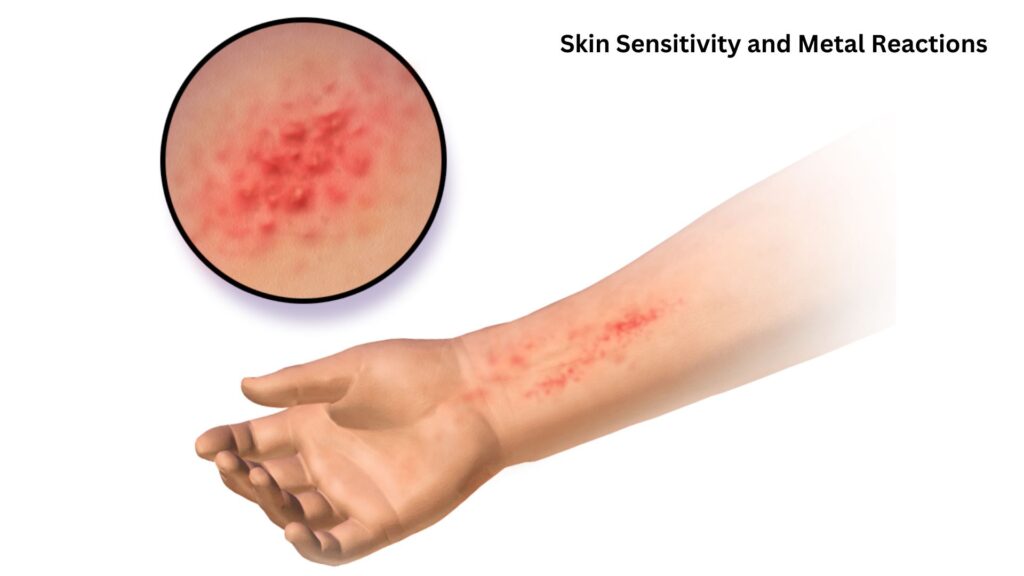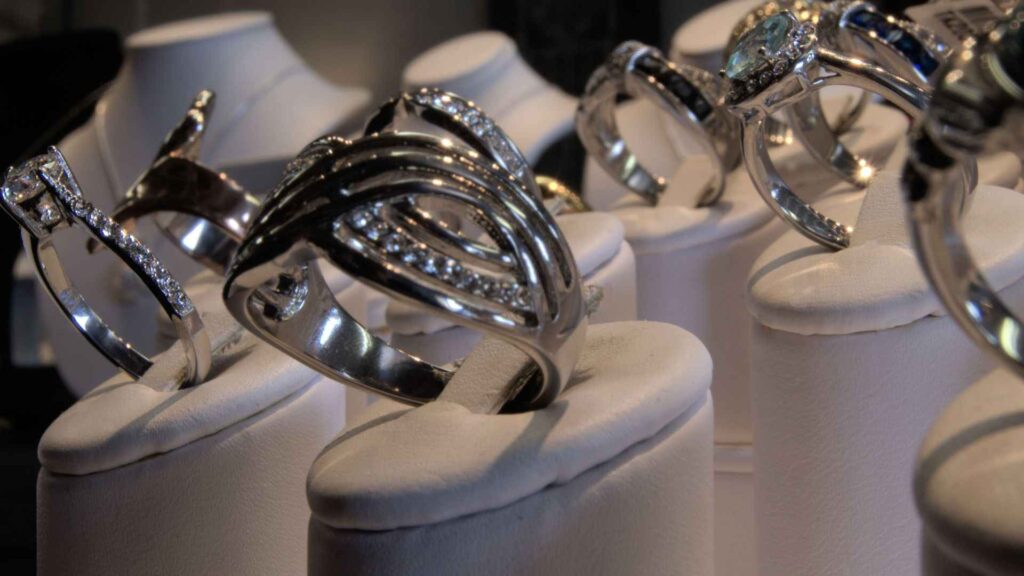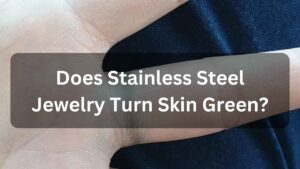
If you are worried about the green tint you get when wearing your best stainless steel necklace then you are not alone in this case.
The answer to this question “Does stainless steel jewelry turn skin green” is not a straightforward yes or no. There are several factors that can lead to these conditions. The green color can be caused by lower-grade varieties containing nickel, sweat, and even certain types of lotions. To solve this problem hypoallergic materials, premium stainless steel, or protective covering can make your style without irritating the skin.
By understanding these factors you can use your stylish jewelry with confidence and without any skin concerns. So let’s discuss it more in detail.
2. The Science Behind Skin Reactions

2.1. Understanding Skin Sensitivity and Metal Reactions
2.1.1. A Complex Interaction:
Allergy-induced contact dermatitis is a condition that is caused by some metals that can skin reactions.
This happens when a charged atom leaches from the metal and contact with the skin. The body’s immune system recognizes the particle as a threat and induces an inflammatory reaction at the contact site that causes itching, redness, and pimples.
2.2. Impact of Metal Composition on Skin
2.2.1. Nickel: The Typical Offender:
Stainless steel is an allow which means it is a combination of various other metals. Pure stainless steel is not likely to react but some varieties contain nickel which is a known allergen reacting with skin protein upon dissolving in sweat causing discomfort and a green color.
2.3. Personal Skin Dynamics: Factors Contributing to Reactions
2.3.1. Beyond the Metal:
Though impure varieties are the cause of green color but several personal factors beyond metal lead to skin reaction. Among them are:
- Skin Chemistry: Skin chemistry also greatly influences the metal reaction to the skin. Factors like natural PH, and specific substances affect the reaction, for example, more acidic PH can speed up the leaching of nickel causing discomfort quickly.
- Sweat and External Factors: Sweat can also speed up the leaching process of nickel from jewelry and irritate the skin. Also, certain medications and lotions can interact with metals.
- Individual Sensitivity: The sensitivity to nickel and other metals varies from person to person. Some people may react highly to a small amount of nickel while others show no response to a high amount of nickel.
3. Understanding Stainless Steel Jewelry

3.1. Stainless Charm and Misconceptions
Stainless steel is a popular choice for jewelry due to its unique blend of characteristics. They are:
- Durability: Stainless steel is a durable metal because of its resistance to corrosion, scratches, and tarnishing which makes it long-lasting for everyday wear.
- Affordability: Compared to precious metals, stainless steel is an affordable choice that offers fashion and style.
- Versatility: This metal is available in a wide range of finishes, from polished to brushed offering a collection of designs.
3.1.1. Beyond the Green Myth:
As already discussed, the green color is not caused by the stainless steel itself but by the content that makes it reactive. So here the importance of quality comes.
3.2. Importance of Quality: Grade and Craftsmanship Can Make a Significant Impact
Stainless steel doesn’t come in one quality. The grade of stainless steel and the quality of craftsmanship play an important role in determining whether it causes any skin reaction.
- Grades and Nickel Content: Lower-grade stainless steel contains higher levels of nickel which can trigger skin discoloration and irritation.
- Craftsmanship and Protective Coatings: Premium quality stainless steel is made with less amount of nickel which can reduce the risk. In addition, some manufacturers coat the stainless steel jewelry with a protective coating to further reduce the nickel leaching.
3.2.1. Understanding Stamps/Hallmarks:
Make sure to check the seals and hallmarks before buying the jewelry. For instance, the stamp 316L indicates the low-nickel variation of jewelry.
3.3. Exploring Alternatives: Choices for Delicate Skin
3.3.1. For Maximum Comfort:
If your skin is delicate and hyperallergic to the nickel you may consider the following hypoallergic alternatives.
- Surgical Steel: Surgical steel is a special kind of stainless steel with reduced nickel content which is a suitable alternative for sensitive skin individuals.
- Titanium: Titanium is a naturally hypoallergenic metal that is famous for its lightweight and durability. It is an excellent choice for individuals looking for fashionable and cozy alternatives.
4. Proactive Measures and Solutions

4.1. Strategies for Sensitive Skin
4.1.1. Prevention is key:
If you have sensitive skin or a confirmed nickel allergy, the following are some proactive measures to reduce this problem.
- Select Hypoallergenic Jewellery: Optforlow nickel content jewelry like titanium or surgical steel (316L grade) as already discussed.
- Invest in Quality: Seek higher grade, protective coated, high-quality stainless steel to reduce the chance of leaching.
- Cleanliness is Crucial: Regularly clean your jewelry from dust, sweat, and lotions that might irritate the skin.
4.2. Researching Substitutes: Skin-Friendly Materials and Coatings
4.2.1. Beyond the Basics:
There are still some more options who still want the varieties for their sensitive skin.
- Precious Metals: Pure gold (24 carats) and platinum are tolerated by most people but they may contain nickel so ask the seller to confirm it.
- Protective Coatings: Some manufacturers coat the jewellery with lacquer which reduces the chance of irritation so this might be a great choice for sensitive skin.
4.3. Consulting an Expert: Seeking Professional Guidance
If you experience severe allergies or other conditions, consult the dermatologist immediately. Professional and expert jewelers can also caliber the jewelry according to your needs which is safe for the skin and also fashionable.
By following these proactive measures you can reduce skin irritation and enjoy your favourite jewellery.
Conclusion:/Summary
So we have learned that the answer to “Does stainless steel jewelry turn skin green?” is not a straightforward yes or no but several factors that can cause a green tint of the skin. High-quality stainless steel is not the factor to causes the discoloration but there is a known allergen called nickel that is included in low-graded jewellery. Also, sweat, medications, and lotions can catalyze the irritation by leaching the nickel molecule to the skin which is considered a threat to the body’s immune system. The immune system then triggers the inflammation reaction causing redness, itching, and pimples.
Choosing premium stainless steel, hypoallergenic materials like surgical steel or titanium, and protective coated jewelry makes your style without irritating the skin. Look for a 316L grade seal while buying jewelry because this shows very low nickel content in the material.
So with understanding and knowledge, choosing the right jewellery becomes a confident and cozy experience.
Share your skin allergy or green tint experience if you have any in your life.
FAQs: Does Stainless Steel Jewelry Turn Skin Green?
Does all stainless steel jewelry turn skin green?
No, all stainless steel jewellery does skin turn the skin green. High-quality stainless steel especially 316L grade has very low nickel content that is unlikely to turn the skin green.
Why does some stainless steel jewelry turn skin green?
Lower-grade stainless steel contains nickel which is a famous allergen. This nickel leaches out to the skin upon reacting with sweat, lotions, or other chemicals and causes a green tint and irritation.
What can I do to prevent my skin from turning green when wearing stainless steel jewelry?
- Opt for high-quality stainless steel: Look for 316L grade stainless steel or hypoallergic materials like surgical steel or titanium that have very low nickel content.
- Minimize sweat and chemicals: Avoid jewelry while sweating or when applying harsh lotions or cosmetics.
- Clean your jewelry regularly: Regularly clean your jewelry with mild soap and water to remove dust, sweat, lotions, or other chemicals that might react with metal.
- Listen to your skin: If you experience any discomfort, remove the jewelry and allow your skin to heal. Consider consulting a dermatologist for further guidance.
Are there any alternatives to stainless steel jewelry if I have sensitive skin?
Yes, there are several alternatives to stainless steel jewelry if you have sensitive skin.
- Surgical steel and titanium: These metals are hypoallergenic with very low nickel content making them safe for sensitive skin people.
- Pure gold (24 karat) and platinum: These precious metals are generally well tolerated by most people but some alloys may contain nickel so always ask the seller about it.
- Jewelry with protective coatings: Some manufacturers apply lacquer coating on jewellery which makes a protective barrier between skin and metal reducing the risk of irritation.
Is there a way to test if stainless steel jewelry contains nickel?
Unfortunately, there is not a simple home test that can confirm the nickel content in jewellery but there are some methods that offer clues to check the nickel content:
- Look for markings: As discussed earlier look for hallmarks in jewellery. High-quality stainless steel with 316L indicates very low nickel content in the jewelry.
- Magnet test: While not guaranteed, some people use magnets to check the nickel content. Generally, low-grade stainless steel with high nickel content is slightly magnetic while pure stainless steel is not. But remember, this method is not entirely reliable and may be misleading for certain alloys
How long does it take for stainless steel to turn skin green?
The duration for discoloration can vary depending on nickel content, sweat level and duration, and individual skin sensitivity. In some cases, it might cause discoloration within hours of wear, while in other cases it might experience no reaction at all.
Can stainless steel jewelry turn any other color besides green?
Yes, in rare cases, the color might be different from green which might be due to other metals in the jewelry alloy or the chemicals, medications, and skincare products on the skin. If you notice any unusual discoloration, it’s best to remove the jewelry and consult a dermatologist.
Should I see a doctor if my skin turns green from wearing jewelry?
If you experience persistent reactions or severe nickel allergy, it’s wise to consult a dermatologist because the doctor can diagnose your skin condition and recommend appropriate jewelry material.
Sources:
https://www.mayoclinic.org/diseases-conditions/nickel-allergy/symptoms-causes/syc-20351529





